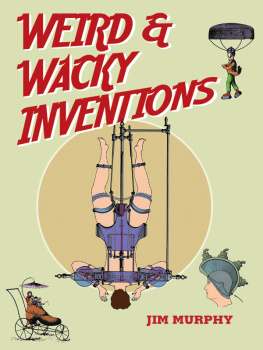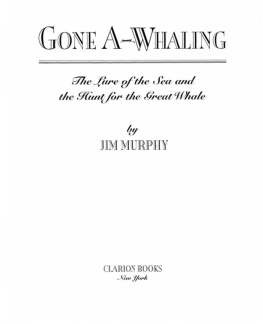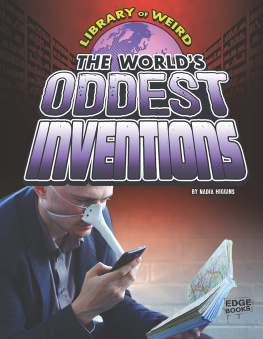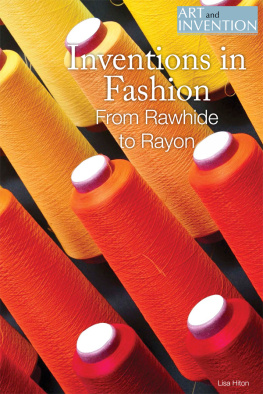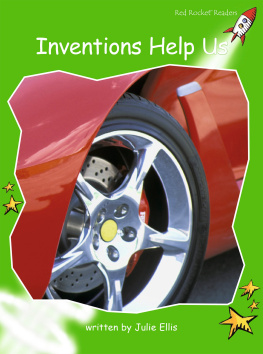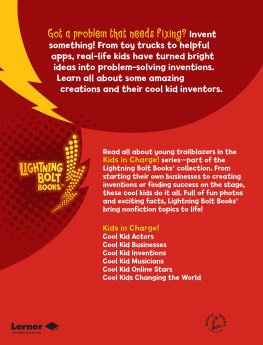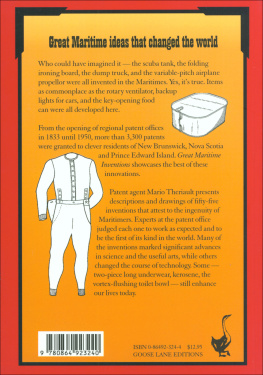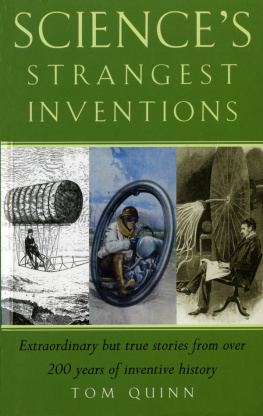Weird & Wacky
INVENTIONS
JIM MURPHY

The first is for Kyran Murphy
Copyright 2011 by Jim Murphy
All Rights Reserved. No part of this book may be reproduced in any manner without the express written consent of the publisher, except in the case of brief excerpts in critical reviews or articles. All inquiries should be addressed to Sky Pony Press, 307 West 36th Street, 11th Floor, New York, NY 10018.
Sky Pony Press books may be purchased in bulk at special discounts for sales promotion, corporate gifts, fund-raising, or educational purposes. Special editions can also be created to specifications. For details, contact the Special Sales Department, Sky Pony Press, 307 West 36th Street, 11th Floor, New York, NY 10018 or info@skyhorsepublishing.com.
Sky Pony and Sky Pony Press are registered trademarks of Skyhorse Publishing, Inc., a Delaware corporation.
www.skyhorsepublishing.com
10 9 8 7 6 5 4 3 2 1
Library of Congress Cataloging-in-Publication Data is available on file. ISBN: 978-1-61608-475-2
Printed in China
Contents

Introduction
O ne day in 1849, Walter Hunt began tinkering with a piece of wire. Hunt was trying to invent an improved type of rifle for the army. One of the things he needed for his rifle was a small wire clasp that could be opened and closed many times without breaking. He also wanted it to have a spring so that it would open easily. After three hours of twisting and bending the wire, Hunt created something he didn't expect. Instead of a clasp to be attached to a rifle, he invented what turned out to be one of the world's greatest little gadgetsthe safety pin.
We all know what a safety pin looks like. Very few of us, however, think of such a common, everyday item as having been invented, let alone wonder who invented it. Look around the room you're in and you'll discover hundreds of things that did not exist before someone like Walter Hunt created them. In fact, just about everything you see or use has been invented: cars, faucets, nails, many types of flowers and plants, refrigerators, televisions, stereos, pens, hamburgers, and the catsup that goes on top.
Since its founding in 1790, the United States Patent and Trademark Office has issued over 4 million patents for inventions of every conceivable kind. Our history books tell us about the most famous inventors, people like Benjamin Franklin, Eli Whitney, Cyrus McCormick, Charles Goodyear, Alexander Graham Bell, George Eastman, and Thomas Edison, to name just a few. Yet a surprising number of inventions were created by people who did not spend their working day in laboratories fiddling with metal, wood, and chemicals. Many of America's inventors were carpenters and mechanics, shopkeepers, artists, teachers, factory and office workersordinary people who simply had an idea they thought would be of some benefit to the general populace.
After these people had thought out their concept as much as they could, and maybe even made a working model of it, they applied to the Patent and Trademark Office for a patent. The general procedure for getting a patent is described at the back of this book; part of the procedure is to supply a drawing of the invention.
What follows is a good-natured quiz involving the patent drawings of some of the lesser-known inventors. Each of the drawings has a clue that hints, sometimes directly, sometimes indirectly, at what the inventions were supposed to do. A number of possible answers accompany the drawing and help you in your guessing.
As you turn the pages, you'll be surprised to discover the many kinds of things that were thought up over the years. Some of them were truly ahead of their time, interesting concepts but too complicated or not efficient enough to operate or manufacture. A few were useful in their time but seem very old-fashioned or quaint to us today. And just about all of them are now considered rather odd, or silly, or, as the title says, weird and wacky.
But we shouldn't judge these inventions too harshly. After all, the things we consider modern now will begin to look strange as new things are invented to replace or improve on them. What is more, each one of the inventions you will see, no matter how outlandish, represents an individual's attempt to come to grips with, duplicate, and in some cases overcome the forces of nature. Each is a step, sometimes a very tiny step, toward making things a little better or faster or more long-lasting. Above all, they are a tribute to the creative spirit that will work long into the night, overcome financial and educational obstacles, and endure ridicule in order to turn a dream into a reality.
chapter one
From the Neck Up
E ach morning we go through a ritual of studying our own sleepy faces in the mirror, brushing our teeth, and combing our hair. Some people will shave, others will put on makeup. Before we go out, we give ourselves a final check to be sure the part of us that sits on our shoulders looks as good as it can.
Inventors have given a lot of thought to the area from our neck up. See if you can figure out what they had in mind when they invented the following things.
T his machine had many gears and springs. It was supposed to be attached to something else, and when the metal arm and ball at the left moved forward, the apparatus went into operation. The invention would make any meeting with the user a polite encounter.

- a head-measuring device
- an automatic tipping-hat
- a hat-and-head cooler
- a machine to stimulate the brain
TIPPING-HAT

In 1896 James Boyle decided the world needed an automatic tipping-hat. The mechanism was first wound up like an alarm clock and then fastened to whichever hat was to be worn that day. Next the wearer put the hat on his head, and a number of curved-spring "fingers" firmly secured both the hat and the machinery in place.
Once the hat was on the head, operating it was simple. The gentleman bowed his head slightly and the arm and ball pendulum shifted forward, triggering the machinery into action. To the amazement of passersby, the hat would tip itself, swing around in a complete circle, and gently settle back into place. If the wearer had an armful of packages, this invention made it simple for him to tip his hat. And the wearer's hair wouldn't even be mussed up. What could be more polite!
Because hats were once worn by so many people, from businessmen to shopkeepers to stagecoach drivers to cooks, inventors lavished much attention on devices for the hat, since their inventions, if accepted, would be sold to thousands and thousands of people. To ensure that a hat fit perfectly, complicated instruments were devised to measure the size and contours of the head. In addition, hats came to be used as hearing aids, spying implements, and, to provide comfort during the summer, there were special hat ventilators

